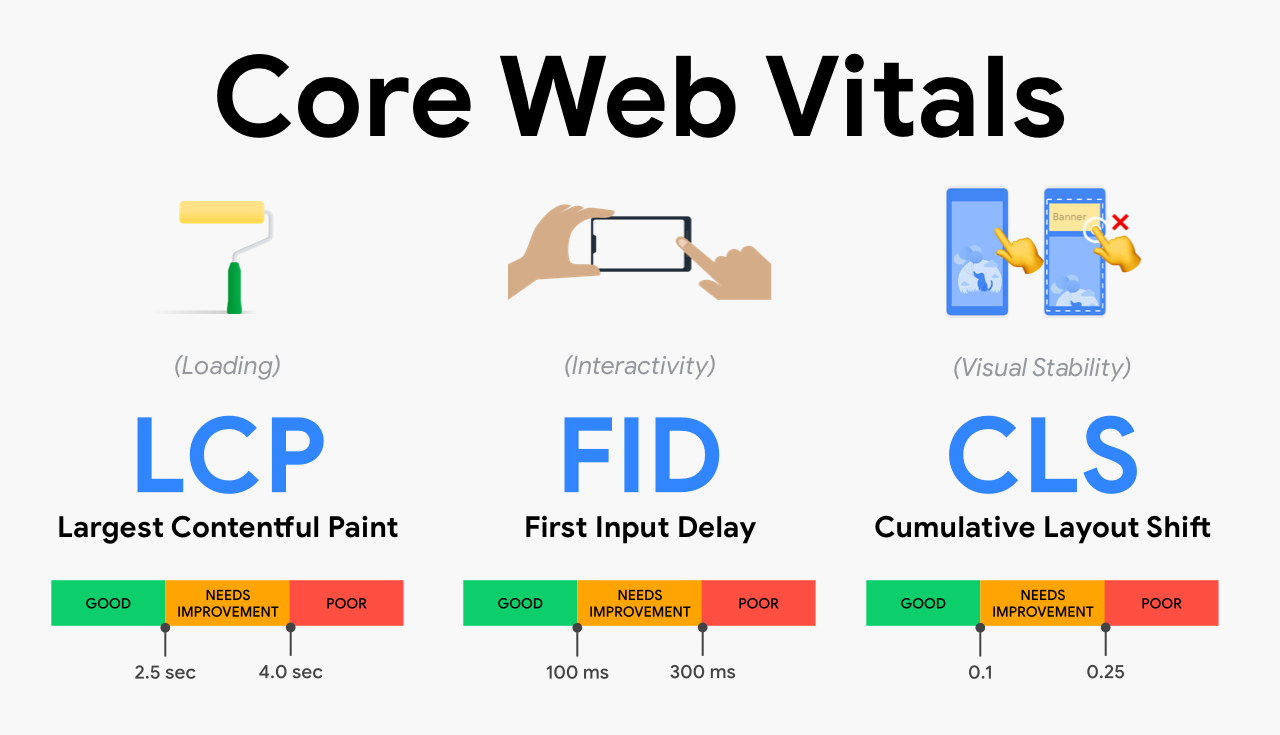According to Google Search Central, “Our vision for page experience is to build a web ecosystem that users love—together. We’re hard at work to make sure that you have the right tools and resources available before the ranking rollout starting in mid-June 2021.”
Have you ever wondered why there is so much emphasis on user experience nowadays? It is one of the most important aspects of creating a website. It is important for businesses because it gives a deep understanding of the customers, their requirements, and likes and dislikes.
In 2020, Google announced that it will roll out new Page Experience Signals and that Core Web Vitals will play a pivotal role in Google’s ranking algorithm system along with already existing search metrics like safe browsing, HTTPS security & a mobile-friendly website, that will be responsible for ranking the website on Google SERPs.
Keeping this in mind, Google is rolling out Core Web Vitals, a new ranking factor in June 2021. Let’s find out what all the hype is about.
Quick Understanding of Google’s New Core Web Vitals Update
- Google first announced in May 2020 that it will be gradually rolling out the new Page Experience update by November 2020. But later in November, they announced that it will be rolled out by May 2021.
- Google officially rolled out the new update in June 2021 but added that it won’t play its full role until the end of August. This update will affect all websites globally.
- The Core Web Vitals will measure a user’s interaction with a web page.
- It should be measured by all website owners and will be surfaced across all Google tools.
- Each metric of the Core Web Vitals is a distinct factor for measuring user experience and it brings out the real-world experience of a user-centric outcome. Google has mentioned 3 elements that are most important for enhancing page experience that is: Largest Contentful Paint i.e. LCP (loading), First Input Delay i.e. FID (interactivity) &
- Cumulative Layout Shift i.e. CLS (visual stability)
- With the rollout of this new update, Google has introduced Page Experience Report in Search Console. This report will provide website owners with valuable insights to help improve the website experience.

The 3 Metrics of Core Web Vitals Explained
1. Largest Contentful Paint (LCP)
It measures how long it takes for the largest visible image or text block to appear on the website. In simple terms, LCP measures a page’s loading time.
Ideal LCP Score
As per the standard set by Google, it should occur within 2.5 seconds of when the page starts to load on the first click.
To-dos for Increasing LCP
- Minify CSS and JS Files
- Compress Text Files
- Remove Unused Javascript
- Optimize Your Images
- Establish Third-Party Connections
How To Fix Issues Affecting LCP
- If your server’s response time is slow, you can solve it by using signed exchanges, routing users to a nearby content delivery network (CDN) & optimizing your web servers.
- To fix slow loading time, you should optimize your images, reduce the number of redirects, cache your website, enable browser caching, eliminate unnecessary plugins, etc.
First Input Delay (FID)
This measures how long a page takes to become interactive. It means the time between the user’s first interaction after clicking on the page link & the browser becoming responsive.
Ideal FID Score
FID is considered good when it is less than 100 milliseconds.
To-dos for Increasing FID
- Reduce Javascript Execution Time
- Optimize Your Page for Interaction Readiness
- Use a Web Worker. It’s possible to run Javascript on a background thread if using web workers.
- Reduce the Impact of Third-Party Code
- Minimize Main Thread Work
How To Fix Issues Affecting FID
- To avoid unresponsive browsers and poor website interaction, you should optimize your web page for interaction readiness, reduce Javascript execution time, use a web worker & long tasks should be disintegrated by your web developer.
Cumulative Layout Shift (CLS)
In simple words, CLS measures visual stability. Visual stability means that the elements on a page should not move around when it is loading.
Ideal CLS Score
All websites should have a CLS score of less than 0.1. A score over 0.25 is considered poor.
To-dos for Increasing CLS
- Include Size Attributes On Your Images & Video Elements
- Reserve Required Spaces with CSS Aspect Ratio Boxes
- Never Insert Content Above Existing Content Except In Response To a User Interaction
- Prefer Transfer Animations to Animations of Properties That Trigger Layout Changes
- Use font: display values with your custom fonts
How To Fix Issues Affecting CLS
- To solve the issue of images without dimensions, you need to include the width and height attributes on your images and video elements. By doing this, the browser will allocate the correct space in the document while the image is being uploaded.
- One of the most common causes of poor CLS is ads. To avoid this problem you can reserve space for the ad slot, eliminate shifts by reserving the largest possible size for the ad slot and based on historical data, choose the most appropriate size for the ad slot.
- For solving the problem of dynamically injected content, you must avoid inserting new content above existing content unless in response to user interaction.
Google rolled out the Core Web Vitals update on Wednesday, 2nd June 2021. Like all core updates, this is a global update and not specific to any region, language, or category. There will be a second release of the core update next month, the July 2021 core update. Some planned improvements for the June 2021 update are just not ready, so Google decided to roll out the parts that are ready and the rest will be released next month i.e, July 2021.
Does your website pass Google’s new Core Web Vitals?
We understand that it can be a lot of information to take and we’re here to help you out. Connect with us at: https://42works.net/contact
We have seen that these core updates are broad & cover a lot of quality issues. If your website ranking was hit by the core update, resulting in low rankings then take an overall view of your website and use the information mentioned above to improve the overall website experience.


